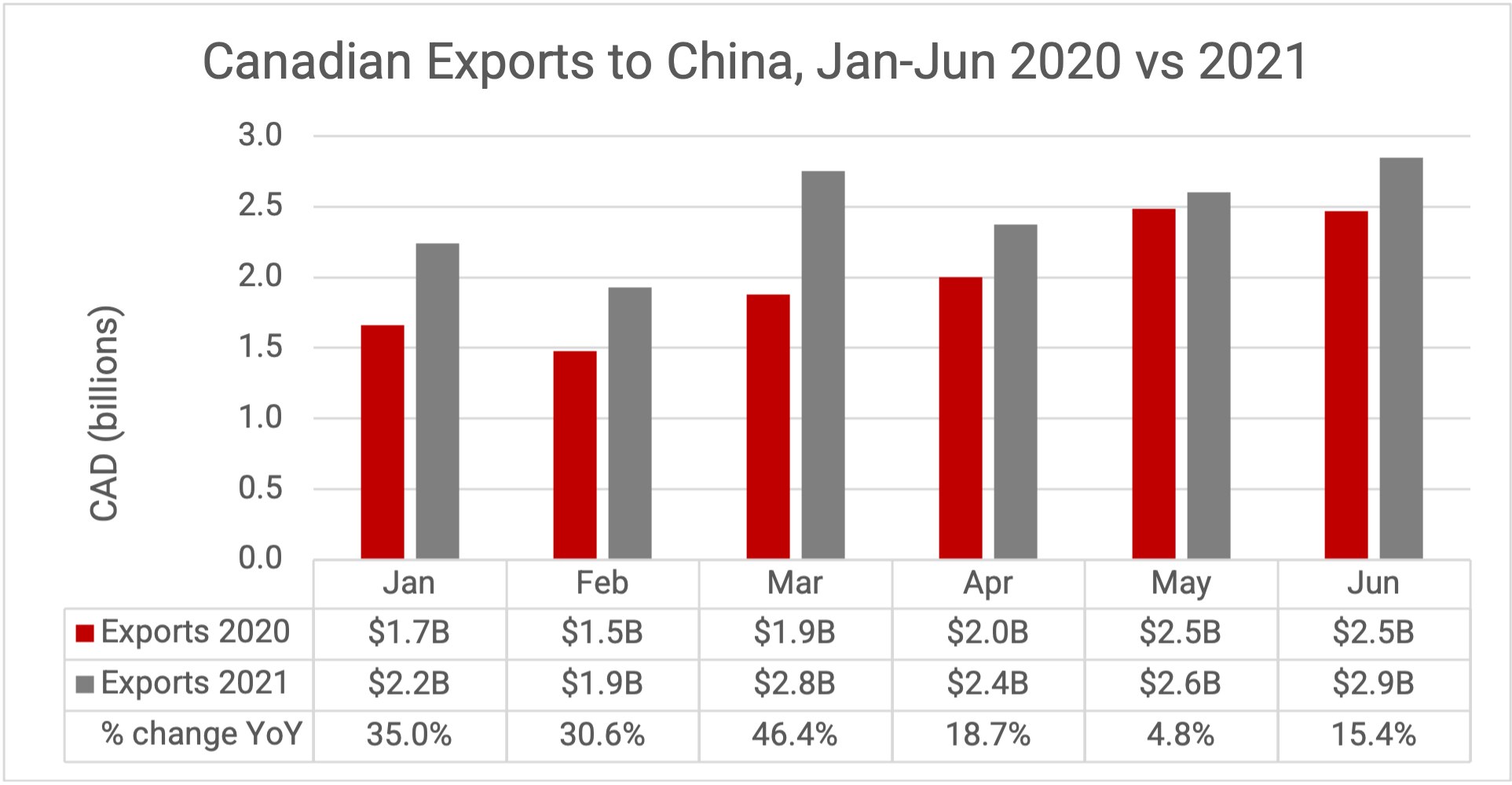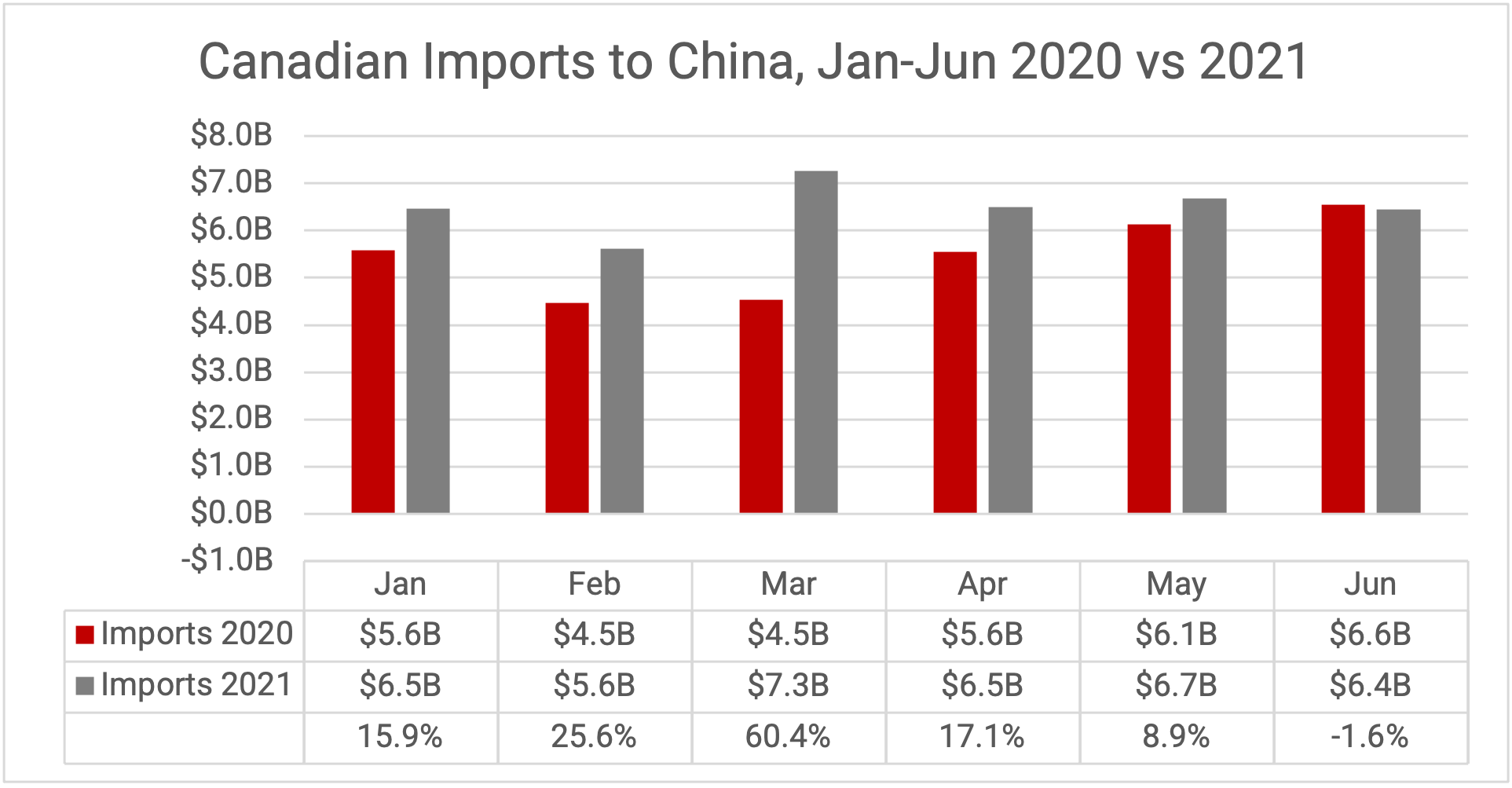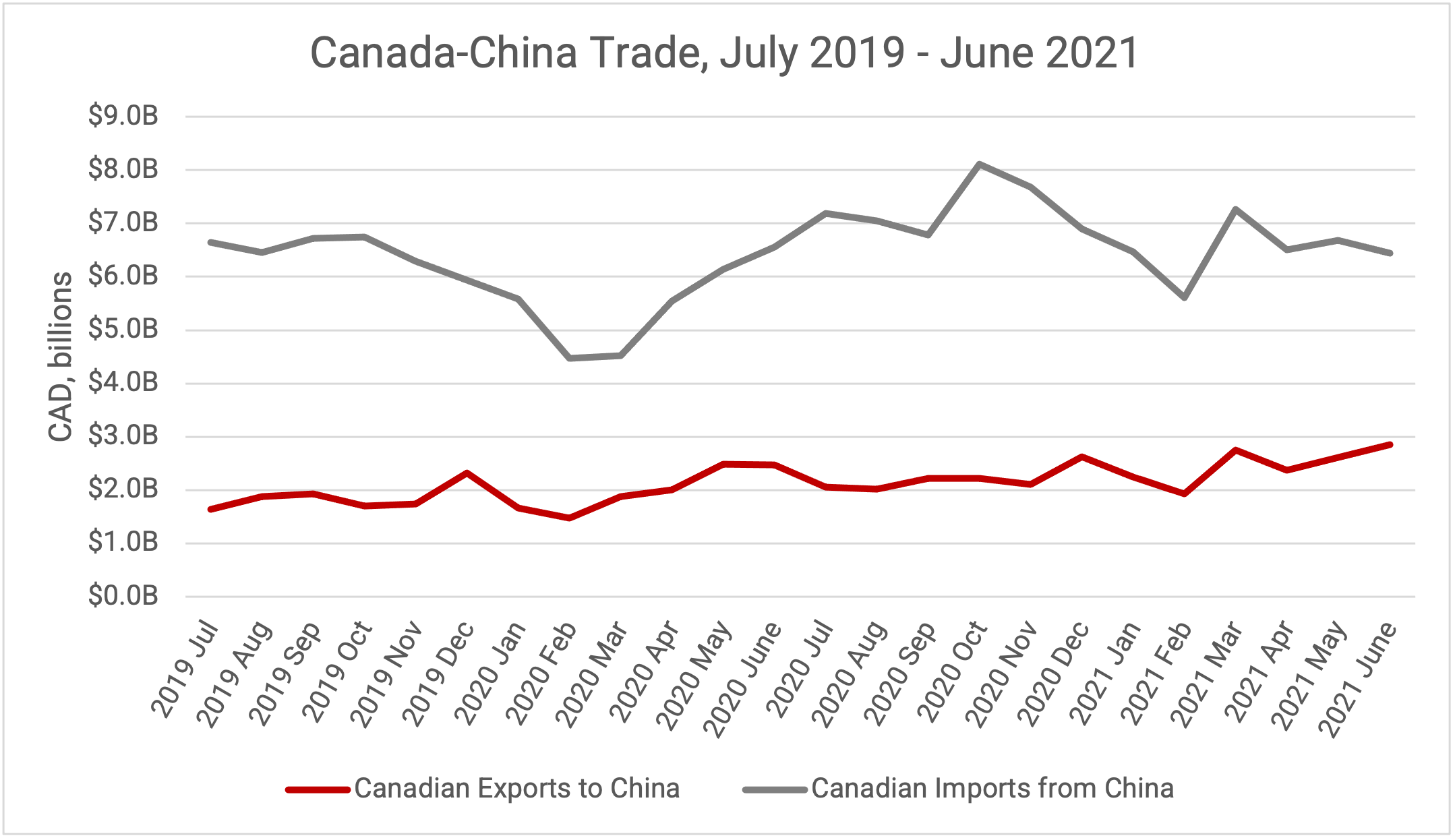Canada-China Trade: 2021 Q2
Darren Choi - 3 November 2021
Canadian trade continued to rebound throughout the second quarter of 2021, reaching well above pre-pandemic levels.
The following data is gathered from Statistics Canada for goods (merchandise) trade with China, presented on an unadjusted customs basis in Canadian dollars (CAD). The relevant HS 6-digit identification code is used to identify individual products.
Canada-China Trade: 2021 YTD
Source: Trade Data Online (Statistics Canada – Customs Data)
Canadian exports to China rose by 23.2% in the first six months of 2021, as compared with the first six months of 2020. This increase is slightly above the year-on-year increase in total global exports for Canada for the first six months of 2021. This jump put Canadian exports to China in the first six months of 2021 far beyond the numbers seen in the first six months of 2019, showing that Canadian goods are flowing into China well above pre-pandemic levels.

The first six months of 2021 saw non-agglomerated iron ores and concentrates reclaim its place as the top export product ($1.25 billion, +29.7% YTD vs. 2020). This was followed by bituminous coal ($1.18 billion, +184.6% YTD vs. 2020), amid a dramatic surge in Canadian coal exports to China (of which bituminous coal is one part). This growth in China’s demand for Canadian coal drew media attention and will be discussed further in Trends & Topics. With that being said, chemical woodpulp ($1.08 billion, +25.0% YTD vs. 2020), copper Ores and concentrates ($1.04 billion, +120.6% YTD vs. 2020), and canola seed ($993 million, +51.98% YTD vs. 2020) ranked as the final three top export categories. 
The first six months of 2021 also saw Canadian imports from China increase by 18.74% as compared to the first six months of 2020. Similarly to exports, the increase in imports from China is slightly higher than the overall increase in total imports into Canada. The first six months of 2021 have seen imports from China land well above pre-pandemic levels.

Consumer electronics dominated Canadian imports from China throughout the first six months of 2021. Laptops ($2.8 billion, +4.1% YTD vs. 2020) were the largest single import category, followed by cell phones came in second place ($2.2 billion, +38.9% YTD vs. 2020). The substantial recovery in cell phone imports after a 35% decline in Q2 2020 suggests a post-pandemic recovery in consumer demand. “Machines for the reception/conversion/transmission/regeneration of voice/images/data,” an import category that includes modems, sits in third ($1.1 billion, +16.6% YTD vs. 2020), children’s toys, puzzles, and models ($513 million, +22.8% YTD vs. 2020) and exercise equipment ($420 million, +224.6%) round out the top 5 import categories. Among these, it is worth highlighting the dramatic increase in exercise equipment imports, which is most likely a product of the pandemic-induced “home-workout revolution.”

Canada-China Trade, Last 24 Months (July 2019 – June 2021)
Source: Trade Data Online (Statistics Canada – Customs Data)
Q2 Canada-China Trade: By Province/Territory
Source: Trade Data Online (Statistics Canada – Customs Data)


Trends & Topics in Canada/China Trade
Canada helps fuel China’s Growing Appetite for Coal
China, already the world largest consumer of coal, has seen a significant increase in its coal consumption through the first six months of 2021. This increase in coal consumption was in large part due to surging demands for electricity in China from both industry and households; a heat wave in the summer pushed electricity demands to record highs but left China’s coal inventories at historic lows. In response, Chinese state-owned firms proposed 43 new coal-fired generators and 18 new blast furnaces through the first six months of 2021. Asian coal prices have soared and output has struggled to meet demand. This is true for metallurgical coal as well, as significant demand for steel has sent prices of metallurgical coal soaring.
Nonetheless, amidst increasing demand, tight supplies, and soaring prices, Beijing has elected to continue its ban on Australian coal. Thus, China continues to exclude a major potential overseas source of coal, forcing the country to look elsewhere for coal sources. Part of the solution has come domestically, as China has approved several new mines and pushed to reopen others. However, safety concerns have slowed this process, particularly after a string of prominent accidents. Thus, other coal exporters, including Canada, have stepped in to fill in the shortage. More specifically, Canada joined other major coal-exporting nations, including the United States, India, and others in significantly increasing their exports of coal to China. Hence, the first six months of 2021 has seen bituminous coal exports to China jump by almost 185%. While this has been economically profitable on the short-term, Canada’s engagement in significant coal exports has raised concerns over the country’s role in driving coal-based emissions, particularly as Canada allegedly looks to phase out its own domestic coal sector.
Canada remains tightly tied with the Chinese economy
It is evident that Canada-China relations frayed throughout Q2 2021, sinking to what many observers call their lowest point in decades. While multiple issues continued to plague the Canada-China relationship throughout the first six months of 2021, the issue of Meng Wanzhou and the two Michaels was easily the most prominent matter. Note, however, that in September 2021 (well into Q3), both Meng Wanzhou and the two Michaels returned to their respective home countries, resolving a stand-off that has lasted nearly three years. We will explore the implications of this resolution to Canada-China trade in the Q3 2021 report.
The steady worsening of the political of the Canada-China relationship has called to question other aspects of the bilateral relationship. Calls to “decouple” Canada and China have grown, including pushes to disengage economically from China, to reduce levels of trade, and to decouple from Chinese science and technology. The potential of further decoupling of Canada and China was prominent enough for the Chinese ambassador to Canada, Cong Peiwu, to publicly warn against the idea of economic decoupling in Canada, when he stated in April 2021 that “[w]e are worried that because some people here in Western countries are preaching the idea of decoupling (with China)”.
Nonetheless, talks of decoupling have persisted throughout the first six months of 2021. As Canada moves forward into a federal election, for example, mentions of decoupling from China are present within some party platforms. However, despite the rhetoric, no significant action towards a decoupling of Canada and China has taken place. Indeed, as evidenced by this report, Canada-China trade remains on the upswing and there have been no signs of disengagement from either side at the present. Only time will tell whether continuing talks of decoupling from China will translate into the tangible disengagement of Canada from China.
Canada-China Canola Row Continues, Canada escalates to WTO Panel
Canola issues have been a regular feature in Trends & Topics in Canadian Trade. Our Q1 report noted that March 2021 marked the 2-year anniversary of market access restrictions for two major stakeholders within the Canadian canola industry, Richardson and Viterra. This issue further escalated throughout Q2, bringing the dispute to the formal dispute resolution mechanisms within the WTO.
The WTO requires nations to attempt to solve trade disputes through negotiations before they can appeal the matter to a formal dispute resolution panel. Canada, on its part, waited over 600 days (well above the 60-day minimum) before finally declaring negotiations had been fruitless and escalating the issue. China blocked Canada’s initial request to form a panel at the June meeting of Dispute Resolution Body, a common response as defendants essentially hold veto power during a country’s first attempt at escalation. This was a procedural move that bought China a mere month; a second attempt at blocking the escalation of the canola case would require a consensus against Canada within the Dispute Resolution Body. Such consensus did not form and, at the next meeting of the Body in July, Canada successfully escalated its case. The Canola Council of Canada has backed the Government of Canada on this escalation, urging that “all necessary actions to restore rules-based predictable trade with China and ensure all Canadian exporters are treated equally by the Chinese administration.”
As of writing, the dispute settlement panel has been formed, but there has been no further reporting on the matter. However, the current dysfunction of the WTO’s dispute resolution system is of concern to all stakeholders within this dispute. The Biden administration has continued the Trump-era policy of refusing to name members to the WTO’s appellate body, which is another key part of the WTO’s dispute resolution framework. The United States has essentially paralyzed the appellate body for the time being. This is a concern for any party in either Canada or China hoping for a swift resolution of the canola dispute within the WTO.
Author

Darren Choi
Policy Research Assistant
Darren Choi is a Policy Research Assistant at the China Institute at the University of Alberta and a BA graduate with a major in Political Science and a minor in history.